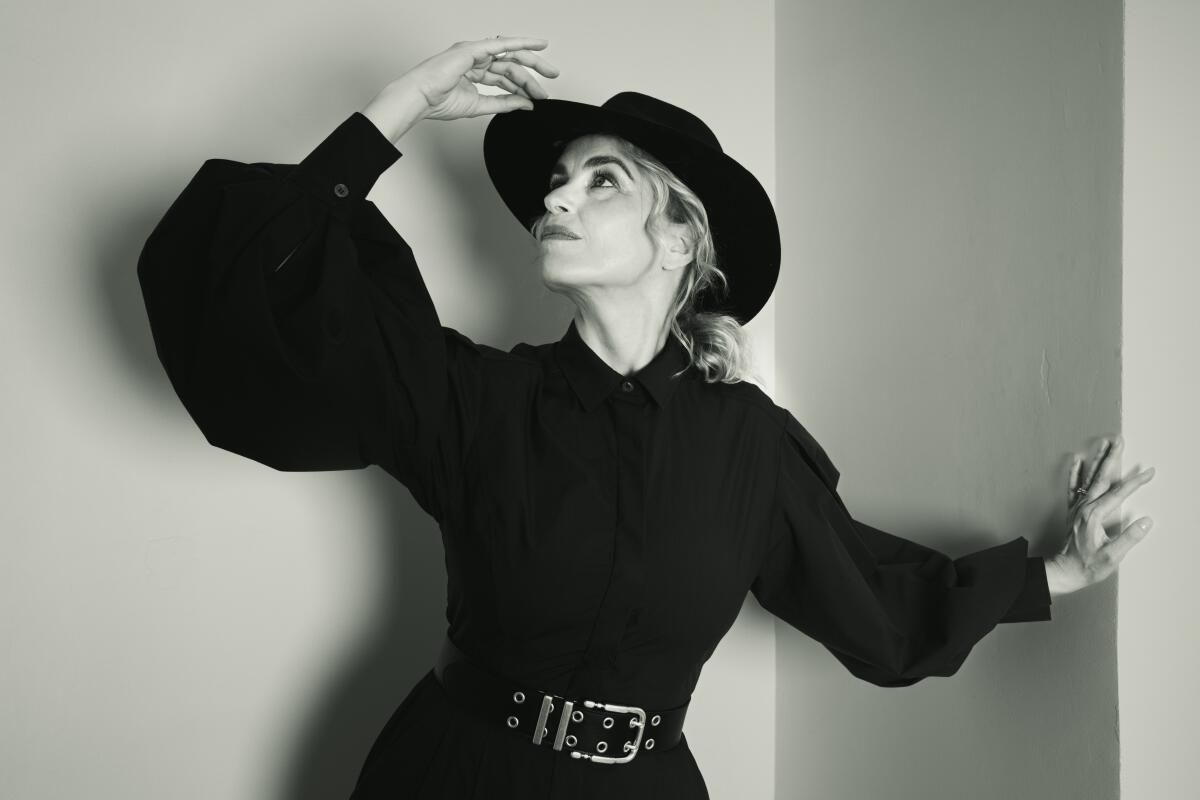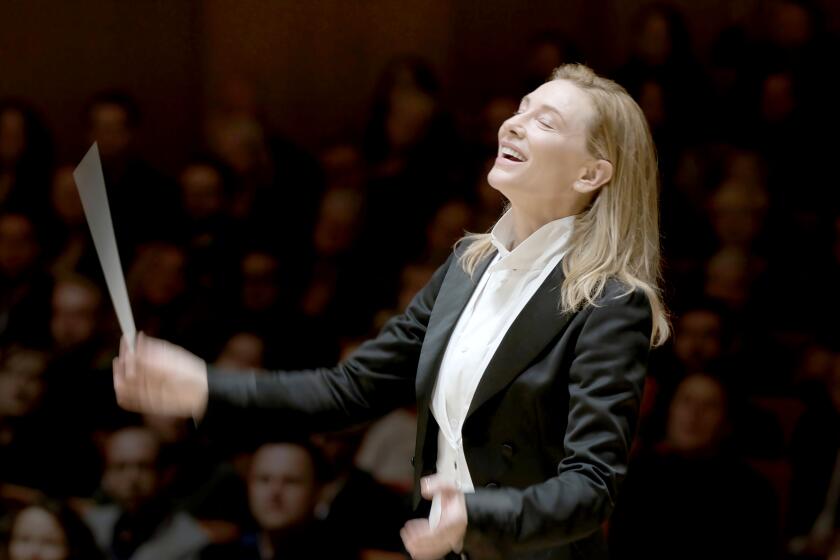Nina Hoss is cheated on in ‘Tár.’ But here’s why she’s not a victim

- Share via
“Tár” doesn’t reveal all its meanings in one sitting, demanding (and rewarding) multiple viewings to unlock its myriad themes and mysteries. Even those involved in its making find this portrait of the enigmatic Lydia Tár a fascinating moving target. “It shifts,” Nina Hoss says. “Every time I see the film, something else [becomes] more important.”
It’s early October and the German actor, looking elegant in a long, dark blue dress and matching sunhat, is sitting poolside on a Beverly Hills hotel rooftop. But her mind is still on the previous evening’s screening of “Tár” at the Academy Museum of Motion Pictures. Hoss said that when she watched the movie this time, “I thought a lot about Lydia as an artist and what it means if you are being put in a position of having to lead other people. We are in a collaborative art form, and if you want to be the head of an institution, what does that actually do to you [when you] need to be very vulnerable and receptive for your art, but [also] in the position of leading? How does power corrupt you? How does it take away the ability [to be] a free spirit?”
It’s no surprise that the 47-year-old actress Hoss is as intelligent and thoughtful as the performances she’s delivered over the last two decades — especially since “Yella,” her attention-grabbing 2007 pairing with filmmaker Christian Petzold, part of a long-running collaboration that culminated in their devastating 2014 postwar drama “Phoenix.” She’s appeared in some American productions — including the Showtime series “Homeland” — but “Tár” will be a revelation for those unfamiliar with her brilliantly steely previous work.
She plays Sharon, the concertmaster and first violinist for the Berlin Philharmonic, who has a young daughter with her wife, Lydia, the symphony’s genius conductor played by Cate Blanchett. Writer-director Todd Field’s drama has many facets, but one of them is the study of this weathered love affair that’s showing signs of fraying.
“Todd Field wants to talk to you” is how Hoss remembers her agent first telling her about the secretive project. A fan of Field’s earlier movies, she quickly hopped on a Zoom call. “He didn’t tell me too much about it,” she recalls. “He said, ‘It’s a part, but I’m not sure if there’s enough meat for you.’ And then he said, ‘The main character will be Cate.’ And I thought, ‘No matter what, I want to do this.’”
Like most everyone, Hoss has long admired Blanchett from afar. But Hoss suspected that perhaps they had similar artistic sensibilities.
“We always heard about each other because we had mutual friends in the theater world,” she says. “She did ‘Hedda Gabler’ [at the Brooklyn Academy of Music in 2006], and I did ‘Hedda Gabler’ [at Berlin’s Deutsches Theater in 2013]. Funny enough, she did the most German play, [‘Big and Little’], and I did the same — I loved her in it, and the way she talked about it when I read interviews, I said, ‘There’s something in common the way we see our work and what we’re interested in.’”
Blanchett plays a renowned classical conductor whose world gradually comes apart in this virtuoso return to filmmaking from writer-director Todd Field (“In the Bedroom,” “Little Children”).
Good timing allowed the two actors to finally be in each other’s company in spring 2021, when they were in Budapest, Hungary, staying at the same motel while working on separate projects. “We had dinner together, we had breakfast,” Hoss says. “We spoke about [‘Tár’], but it was more getting to know each other. And that helped for the film, because we felt secure with each other.”
That familiarity paid off when she, Blanchett and Field fleshed out the characters’ backstory, finding the “meat” that he felt he hadn’t initially provided Hoss. Because Lydia takes advantage of her power position to engage in affairs, it’s tempting to view Sharon as weak for staying with her unfaithful spouse. But Hoss disagrees.
“She is not a victim in this relationship,” she insists. “She gets something out of it as well. As long as [Lydia] comes back, Sharon is OK with it. That’s how some relationships work, and they work very fine. We spoke a lot about that — how they came together and just fell madly in love through music. I think they were great lovers; they’re very comfortable with each other.”
These small but meaningful details added texture to the script, even if those details are never revealed in the finished film. (For instance, Hoss decided that Sharon had never been with a woman before falling for Lydia.) But other aspects of Sharon’s makeup were more apparent. As the orchestra’s concertmaster, Sharon isn’t simply front and center but also the other players’ guide, and Hoss worked with her violin teacher to understand the importance of Sharon’s position. “The way you hold yourself — you’re not the violinist in the third row who can sometimes slouch in the rehearsals,” says Hoss. “The first violin is always in there” — suddenly, Hoss sits up a little straighter, exuding effortless authority. “Everyone is always looking at you.”
In her research, Hoss learned how rare it is for both the conductor and the concertmaster to be women. She got a taste of the obstacles facing creative women at a young age. “My mother was an actress first, and then she became a director,” she says, referring to Heidemarie Rohweder, who died in 2014. “She was actually the second female head of theater in Germany. My mother had to struggle more than Lydia did being a woman in this position; I clearly experienced that with her as a child. But it taught me how to navigate things. What I learned through watching her is, in this job, never take it personally. The business, that’s a game — you can’t take that personally at all.” If Hoss doesn’t get a role, her attitude is simple: “So what? Move on, next.”
Hoss is still thinking about the previous night’s screening, how “Tár” keeps twisting around in her mind, refusing to be pinned down. She’s intrigued by what the film has to say about how artists — especially female artists like herself — respond to criticism from the outside world. It’s never easy, but Hoss has been grateful even for the tough feedback.
“If everyone always said how great [I am], I would’ve been a terrible actor,” she says. “Especially when you’re young, you think you’ve got it all worked out. But at a certain point you go, ‘No, no, no, no’ — [you think] it’s all about you, but art is not about you. It’s not — otherwise, you don’t open a conversation. Art is about so much more — it’s about the world we live in, the questions that come up for you.”
More to Read
From the Oscars to the Emmys.
Get the Envelope newsletter for exclusive awards season coverage, behind-the-scenes stories from the Envelope podcast and columnist Glenn Whipp’s must-read analysis.
You may occasionally receive promotional content from the Los Angeles Times.








